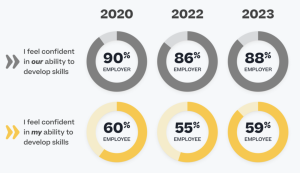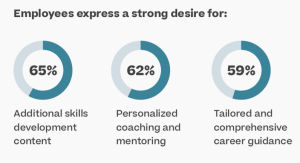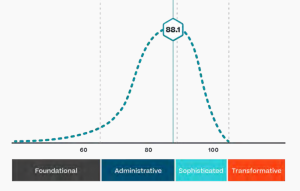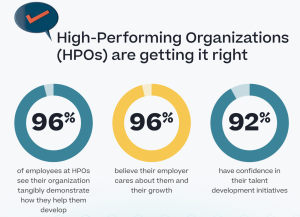If there’s one key outcome all HR professionals have to get right at the moment, it’s that they must equip staff to be able to respond properly our increasingly VUCA (volatile, uncertain, complex and ambiguous) world.
To do this, the strategy that comes up time and time again is that staff need to be re-skilled so that they can better respond, and be more agile to change.
But how good a job are organizations doing in this regard?
Often in conversations like this, commentators will default to talking about the very clear “gap” between what employers think they’re providing, and what employees see and feel in reality.
Bosses – on the whole – tend to think they’re doing a great job at providing the tools for staff to reskill; employees at the coalface, meanwhile, typically tend to disagree.
This is yet again one of the main findings of new research by Cornerstone OnDemand – which has just published its latest Talent Health Index, and which is rather suggestively entitled ‘Mind the Gap’.
TLNT was invited to a join a special briefing where Mike Bollinger, global VP, (strategic initiatives) at Cornerstone OnDemand, and some of the findings are particularly stark:
“We know HR has been through a turbulent time,” he says.
He adds: “We also know things are for HR aren’t getting any easier. But, when groups like the Economic Forum find that 44% of workers’ core skills are expected to change within the next five years, this is something HR has to seriously respond to. And the worrying fact is that only 30% of CEOs think that their staff have the right skills.”
More worrying than this, is that according to Cornerstone’s research, there is a large, and perturbing gap between employers’ confidence in their ability to raise the skills of their staff, and confidence of this happening from staff themselves.

It finds employers’ confidence in their ability to develop the skills of their employees has remained fairly consistent over the past two-three years, with around 88-90% of employers feeling very confident they can raise the skills of their people.
But not only is there a big gap between this and staffs’ own assessment of this, but during this same time frame, employees’ confidence that their skills can be developed has actually worsened (see below).

“Currently the gap is big; 41% of staff don’t think they’re getting what they need to develop their skills,” says Bollinger.
“Not only is this worrying, but it’s disappointing for staff – because they’re actually realizing the need to upskill for their own future job security.”
He adds: “The problem is, they’re just not getting the support they want. We find 65% of staff are specifically looking for additional learning content. In addition to this, 62% of employees are eager to find more coaching and mentoring and 59% of employees are on the lookout for more career guidance.”

What’s going wrong?
Such is the level of this gap, Cornerstone defines the skills development level that most organizations demonstrate as being at just the ‘administrative’ level.(rather than being ‘sophisticated’ or ‘transformative’).

At this administrative level, talent programs are deemed to be behind in automation and have yet to build a robust learning strategy.
At this level companies are demonstrating a mastery of the basics and very early exploration of new innovation, but they are behind the talent development curve.
In fact, it finds only 37% of administrative organizations say they leverage learner-centric tools to streamline talent processes and info, and more than 60% of these organizations admitted they are not yet leveraging AI technology to optimize their talent.
But there is a surprising reason as to why this might be.
“We know most organizations are being slow to adopt new innovation,” says Bollinger. “But we anecdotally suspect that there is also an investment confidence gap too – where firms are wary of putting too much spend in compared to what they might get out.”
What has to change?
The only way employers/HR professionals can get out of this rut, suggests Bollinger, is for those at the ‘administrative’ level to see how they compare to those at more advanced skills development levels – because he argues the gulf is huge.
“Amongst organizations that rated themselves as High Performance Organizations (or HPOs), our Talent Health Index found that these businesses generally landed in the ‘sophisticated’ level and specifically, exemplified higher maturity levels in three key areas: content strategy, skills strategy and
performance management.”
He added: “We found that it is only HPOs that focus on identifying current and future skills and whether they are aligned to business strategy (77% for HPOs; 46% for average organizations and 24% for those described as ‘laggards’).”
He continued: “In terms of aligning learning to skills and strategy, the figures are even clearer: 81% of HPOs use talent reviews, whereas it’s only 52% for average performers, and 20% for laggards.”
Those that invest reduce the skills confidence gap
What is perhaps the most compelling data however, is the difference between the skills confidence gaps between HPOs and average/laggard companies.
HPOs report having just a 6% skills confidence gap – in other words, the gap between what employers think they’re delivering, and what employees see is five times smaller than the average organization.
Employees at HPOs also rated their talent programs higher in key areas related to development and opportunity:

Bollinger says: “HPOs are known to work harder to support their employees when setbacks occur. Some 51% of HPOs are using AI or machine learning – so even they have some way still to go. But the fact is, HPOs are thinking ahead. We found 51% of HPOs are developing the skills of their people for the future. This compares to 35% of average companies doing this, and 27% for laggard companies.”
He concludes: “Skills confidence gaps are stubbornly persistent, but we know that investment in skills development – particularly AI – will increase talent health effectiveness.”
